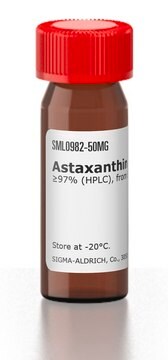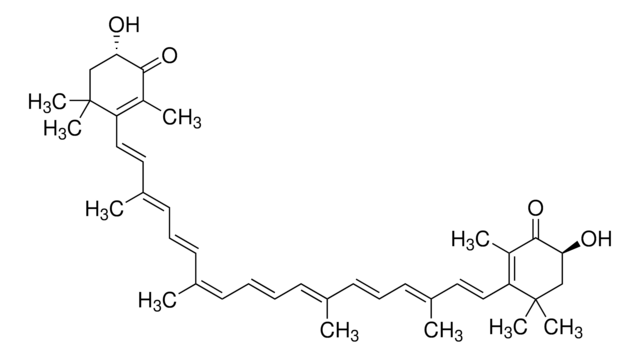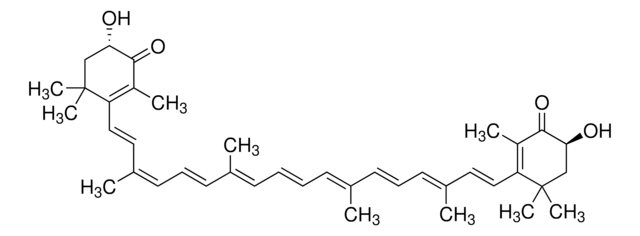41659
all-trans-Astaxanthin
analytical standard
Synonym(e):
Astaxanthin, 3,3′-Dihydroxy-β,β-carotene-4,4′-dion
About This Item
Empfohlene Produkte
Qualität
analytical standard
Qualitätsniveau
Assay
≥97%
Haltbarkeit
limited shelf life, expiry date on the label
Methode(n)
HPLC: suitable
gas chromatography (GC): suitable
Anwendung(en)
cleaning products
cosmetics
food and beverages
personal care
Format
neat
Lagertemp.
−20°C
SMILES String
CC1=C(/C=C/C(C)=C/C=C/C(C)=C/C=C/C=C(C)/C=C/C=C(C)/C=C/C2=C(C)C([C@@H](O)CC2(C)C)=O)C(C)(C)C[C@H](O)C1=O
InChI
1S/C40H52O4/c1-27(17-13-19-29(3)21-23-33-31(5)37(43)35(41)25-39(33,7)8)15-11-12-16-28(2)18-14-20-30(4)22-24-34-32(6)38(44)36(42)26-40(34,9)10/h11-24,35-36,41-42H,25-26H2,1-10H3/b12-11+,17-13+,18-14+,23-21+,24-22+,27-15+,28-16+,29-19+,30-20+/t35-,36-/m0/s1
InChIKey
MQZIGYBFDRPAKN-UWFIBFSHSA-N
Suchen Sie nach ähnlichen Produkten? Aufrufen Leitfaden zum Produktvergleich
Allgemeine Beschreibung
Anwendung
- Microalgae (Green algae), Haematococcus pluvialis using high-performance liquid chromatography (HPLC) with mass spectrometric and fluorescence detection (HPLC-FLD).
- Parapenaeopsis hardwickii using high-performance liquid chromatography (HPLC) with photodiode array detection (PDA).
Biochem./physiol. Wirkung
Verpackung
Lagerklassenschlüssel
11 - Combustible Solids
WGK
WGK 3
Flammpunkt (°F)
Not applicable
Flammpunkt (°C)
Not applicable
Persönliche Schutzausrüstung
Eyeshields, Gloves, type N95 (US)
Hier finden Sie alle aktuellen Versionen:
Besitzen Sie dieses Produkt bereits?
In der Dokumentenbibliothek finden Sie die Dokumentation zu den Produkten, die Sie kürzlich erworben haben.
Kunden haben sich ebenfalls angesehen
Protokolle
HPLC Analysis of Carotene Compounds on Ascentis® RP-Amide
Verwandter Inhalt
Separation of Astaxanthin; Xanthophyll
Unser Team von Wissenschaftlern verfügt über Erfahrung in allen Forschungsbereichen einschließlich Life Science, Materialwissenschaften, chemischer Synthese, Chromatographie, Analytik und vielen mehr..
Setzen Sie sich mit dem technischen Dienst in Verbindung.












